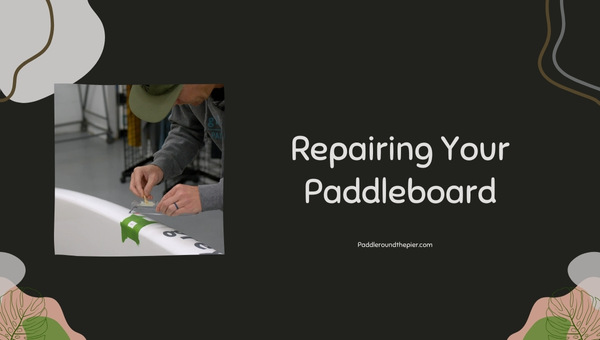Mastering Paddle Board Maintenance: The Essential Guide
If you've taken the plunge and invested in a paddle board, you're likely keen to make sure it lasts as long as possible. The key? Regular and thorough paddle board maintenance. In this guide, I'll be sharing practical tips and knowledge on maintaining your beloved board to keep it in tip-top shape for those glorious days spent out on the water.
Paddleboard maintenance isn't just about wiping off dirt or emptying water; it's more intricate than that! It is an art - one that involves getting to know your paddle board better, regular inspections, proper handling procedures, and knowing when it’s time for a good scrubbing or even professional help. Essentially, our relationship with our boards should be like any other cherished possession - cared for with love and attention.
What You Uncover Within This Article:
- Insightful tips to identify potential harm factors for your paddle board
- Detailed advice on effective handling & storage solutions
- Comprehensive steps for regular inspections & the best cleaning practices
- Resourceful instructions on DIY repairs and guidance for seeking professional help
Paddle Board Maintenance: Ensuring Longevity

Arguably, one of the best pleasures I can experience is paddling on the serene waves and enjoying the tranquility water brings. However, part of this enjoyment circles back to paddle board maintenance - a critical aspect that ensures the longevity of my board. Let's delve into understanding a paddle board first.
Knowing Your Paddle Board
Before diving into paddle board care and maintenance, it's crucial to understand its components like the back of my hand:
- Deck Pad: This provides grip and cushions my feet during paddling.
- Handle: Situated usually at the center, aiding in carrying the paddleboard.
- Fins: Provide stability and control over direction during paddling sessions.
- Leash Point: Acts as a tether point for leash attachment.
Each component of a paddleboard contributes to its performance. Thus, taking care of each part ensures an elevated experience when I'm out in the water.
Paddle Board Maintenance: A Necessity, not a Choice
Maintaining my paddle board isn't merely about preserving aesthetics; it's far beyond that. Providing regular care ensures:
- Longer lifespan: Routine cleaning helps prevent depreciation due to external factors such as UV rays or saltwater.
- Optimal performance: Taking good care minimizes performance hitches like drag caused by damage or dirt buildup.
- Tracking improvement over time: Regular inspection allows me to track any potential issues that might surface over time.
Paddle board maintenance is undeniably an integral part of enhancing every water adventure's quality. It isn't just about extending longevity but also ensuring I get the most out of every wave I ride on.
Protecting Your Paddle Board from External Damage
Protecting your paddle board from damage should be a priority. After all, it's an investment that not only carries a monetary value but also holds countless memories of thrilling rides and calming waves. Proper handling and optimal storage conditions are essential for the preservation of your beloved paddle board.
Proper Handling
I cannot stress enough how important correct handling is in preventing unnecessary wear and tear on your paddle board. Mishandling can lead to scratches, dents, or even serious damages that could bear heavily on the performance and lifespan of your board.
- To prevent this, always carry your paddle board using both hands. This helps distribute the weight evenly across the board, minimizing strain on any particular point.
- Avoid dragging the paddle board along rough surfaces as it may cause severe scratches or dents.
- Place your paddleboard gently in water; dropping might result in damage.
Remember: Treat your paddleboard with respect; handle it as you'd handle delicate vintage china - with utmost care!
Storage Solutions
Storing your beloved paddleboard correctly after each use is another crucial way to cut down unnecessary wear and tear. The incorrect storage environment could harm the material integrity of your paddling buddy over time.
- Wherever possible, store indoors: Less exposure to harsh weather means reduced chances of damage inflicted by temperature fluctuations or UV rays.
- Maintain a cool, dry environment for storage. At extreme or fluctuating temperatures, damages may occur over time.
- Clean thoroughly before storing away: Remnants of saltwater or freshwater could gradually corrode some parts if left unchecked.
- Keep it off direct contact with floor surfaces using rack stands.
Regular Inspection and Cleaning as Part of Paddle Board Maintenance
An important aspect of paddle board maintenance involves regular inspections and cleaning. This practice isn't a chore but rather a preventive stride that will shield your much-loved paddle board from unnecessary damage.
Regular Inspection Tips
Regular inspection can extend the lifespan of your paddle board immensely. By taking time to examine it after every use, you'll spot minor issues before they snowball into major problems.
Here are some tips for conducting thorough inspections:
- Check the Deck Pad: Look for any wear and tear on the Deck Pad. This is where you stand on your board, so it's more prone to wear out with time.
- Joint Inspections: Pay close attention to the joints where different parts meet. These areas tend to accumulate grit and may begin showing signs of separation.
- Fin Checks: The fins should always be firmly attached without any wobbles or loose screws.
- Surface Scrutiny: See if there are any dings or cracks on the surface of your paddle board. They might be small, but they can let water into the foam core if not addressed immediately.
Best Cleaning Procedures
After using your paddle in saltwater or freshwater environments, there will likely be residue left behind that could potentially harm your ride over time.
Here's how to clean it:
- Start With Fresh Water Rinse: Hose down your equipment with fresh water, ensuring that all areas (including nooks and crannies) get a gentle shower.
- Soap Application: Using mild soap makes the removal of salt deposits easier, especially when using a soft bristle brush for scrubbing.
- Dry Thoroughly: A thorough drying session afterward is essential — do this out of direct sunlight if possible, though, as continuous exposure to UV rays could lead to fading colors.
- Inspect Closely: After the board is dry, do a detailed inspection for any hidden issues that need attention.
- Store Correctly: The last step concludes our paddle board maintenance routine - ensuring that the paddle board is stored in a cool and dry place away from sunlight.
Routine check-ups paired with thorough cleaning are the lifeblood of elongating your paddle board’s lifespan and maintaining its performance - your board will thank you for it! Don't skip on these aspects of paddle board care in order to keep enjoying the waves without major hiccups.
Repairing Your Paddleboard

No matter how diligently you maintain your paddle board, there will come a time when some form of repair is necessary. Knowing when and how to implement these repairs can play a significant role in your paddle board maintenance and enhance its lifespan.
DIY Repairs Tips
While it might seem daunting, many paddle board issues can be fixed at home with some simple repair tricks. Here are some techniques that have proven valuable:
- Patch Up Small Dings: The accidental scrape or ding here is virtually unavoidable. However, they are usually minor and can be filled using epoxy resin kits designed for paddle boards.
- Fix Scratches and Scuffs: Surface scratches or scuffs do not affect your board's performance but can impact its aesthetic appeal. You can buff them out using sandpaper (fine grit) followed by a minor paint touch-up.
- Kit Contents: Always keep duct tape, epoxy resin kit, UV protectant spray, etc., as part of your home repair arsenal.
Please remember that most DIY repairs work best for surface-level damages. More substantial damage requires more extensive remedies, potentially necessitating professional support.
When To Seek Professional Help
Paddle Board Maintenance isn't always a DIY project – specific issues should be addressed by professionals:
- Cracks or Damages to the Core: If you notice a crack deep enough to have hit the core of your board, it's best to seek professional help. Such situations often require replacing parts of the SUP's inner foam core—definitely not a job you want to tackle yourself!
- Delamination: This happens when the outer shell separates from the inner foam core, creating bubbles on your once-smooth SUP surface. A professional can ensure that this repair maintains structural integrity.
- Persistent Leaks: If water seems to make its way into the interior after multiple self-help attempts, consult an expert. It could indicate internal damages that are hard to spot.
Paddle Board Maintenance requires a healthy balance of professional care and DIY spirit. However, make sure to handle your paddle board with care, and it will provide you with grand adventures for years on end! Remember – proper care goes a long way towards ensuring longevity, so ensure regular inspections, thoughtful handling and storage, and attentive repair works when necessary.
FAQs
How often should I clean my paddle board?
It's best to clean your paddle board after every use, especially if you've been in saltwater. This helps prevent any salts or pollutants from impacting the board's surface.
Why is it necessary to regularly check or inspect my Paddle board?
Regular inspection helps identify minor issues that could turn into major problems over time. For example, a small crack might not seem like a big deal but can worsen quickly if left untreated.
What kind of damages should I look out for?
The most common types of damage include dings, scratches, and cracks. Also, pay attention to the grip pad - if it's coming loose, that needs attention too.
Can I use homemade cleaning solutions as part of my maintenance routine?
Yes, simple mixtures of vinegar and water or baking soda can be effective cleaners for your paddle board. Just remember to rinse thoroughly afterward!
How to repair a ding in a paddle board?
Minor dings can be patched with an epoxy repair kit. Clean the damaged area thoroughly first, then apply the epoxy patch following the manufacturer's instructions carefully.
Conclusion
After immersing ourselves in the world of paddle board maintenance, it's clear how essential is the care and upkeep for ensuring a long-lasting paddling experience. Equipped with knowledge about paddle board parts, their functions, and crucial maintenance tips, handling and storage solutions that prevent external damage become second nature.
Crucial habits like regular inspections and cleaning keep minor issues from growing into major problems. And while DIY repairs can be handy, knowing when to seek professional help is just as important. This full spectrum of paddle board care contributes significantly to safeguarding my investment while uplifting every single stroke in the waters.
Key Takeaway Points:
- Understanding your paddle board down to its components promotes effective care
- Regular paddle board maintenance extends life-span and enhances experiences concurrently
- Proper handling and optimal storage conditions curb unnecessary wear & tear
- Consistent cleaning coupled with periodic inspections catch minor issues early
- DIY repairs are useful, but knowing when to seek professional intervention is critical